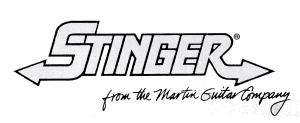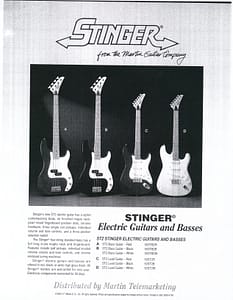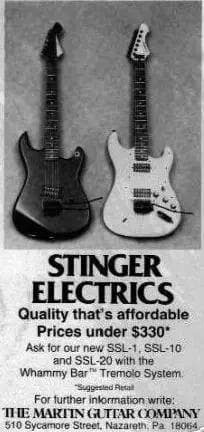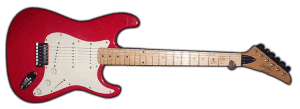
Stinger by C.F. Martin
In 1985 Martin unveiled its Stinger line of solid body electric guitars. These were manufactured on the Southern Korean peninsula (south of the DMZ). This was coincidentally during the same period in which there was a dramatic increase in quality among Korean manufacturers.
As with most other imported Martin products, Stinger guitars were made in Korea and shipped to the Martin factory for a final inspection and set-up, before being sent on to dealers. Essentially, Martin Stingers are well-made entry level guitars pretty much following conventional lines of the marketplace.
Martin never produced Stinger catalogs, so a detailed accounting is pretty difficult. However, there were four basic Stinger body styles, a fairly conventional Strat shape, a Strat-style with an arched top, a Tele and a Fender-style bass.
These came in a variety of finish and pickup configuration options. Headstocks were a kind of modified Strat-style six-in-line, with a pointed throat and slightly hooked nose, with a painted triangular Stinger logo running under the strings. All had bolt-on maple necks. Guitars had a 25.4 scale, while the basses were 34ers.
The principal difference among the Strats was in finish options. All had 21-fret maple necks, three single-coil pickups, volume and two tone controls, and five-way select.
-
SWG (basic red or black, with maple board and chrome hardware. These had traditional non-locking vibratos)
-
SGV (red with white graphics)
-
SSX (duskey, with purple burst (white outside, purple in center), tiara turquoise, blue pearl, metallic white, black and candy apple red finish options, with matching colored maple fingerboard and matching chrome hardware.
The arched-top Strats
-
SSL-1,
-
SSL-10
-
SSL-20.
The Tele
-
STX (humbucker at the bridge and a single-coil at the neck. This had volume and tone, three-way select and a mini-toggle coil-tap on the bucker. Fingerboard was rosewood, while hardware was black chrome. Finish options included cream, metallic red, purple burst and black.)
Basses
-
SBX
-
SBL-10
The core of this early Stinger guitar line can be seen in an undated flyer which could be anywhere from around 1986 to 88.
By the Fall of 1988 the Stinger line, as reflected in a November price list, had rearranged slightly. Still around were the SWG ($281), SGV ($294), SSX ($308), and STX ($330) guitars and the SBX ($337) and SBL-10 ($367) basses, the black SSX and SBX now available in lefty versions (add $15). Essentially these were unchanged in options.
New was the SSX-N ($347), basically the three single-coil SSX with an ash body and natural finish, set off with black hardware and a fixed bridge/tail assembly.
The arched top Strats were still available, but now with new names and details. Gone were the one-pickup SSL-1
Serial Numbers
I called Martin Guitar company to try to get some information on my Stinger, I assumed since I had the serial number I could have Customer Service look it up and give me model, model number, year of manufacture, etc. It turns out that Martin didn’t keep track of the serial numbers.
Letter from Martin Customer Service:
Thank you for contacting the C.F. Martin Co. Inc.
Martin did not keep record of the serial numbers on the Stinger Series; therefore, the history on this series is very limited. Here is the information that I have available. In November, 1985 Martin introduced the Stinger Series solid body electric guitars and Basses. Made in Korea, these guitars became widely accepted in a short period of time. Stinger, like Sigma, was brought into the Martin factory, inspected, and set up by C.F. Martin personnel. They were available in a variety of popular styles. There are no longer stock replacement parts for Stinger Electric Guitars.
Thanks for your support.
C. F. Martin & Co., Inc.
Name Removed for Privacy
Consumer/customer Service
Stinger Guitar Specs
| MODEL SPECIFICATIONS FOR STINGER ELECTRIC GUITARS & BASSES | |
| MODEL #: | ST-2 Stinger Electric Guitar |
| BODY STYLE: | Strat Style |
| NECK: | Maple |
| NECK WIDTH AT NUT: | 1 5/8″ |
| FINGERBOARD: | Maple |
| FINGERBOARD INLAY: | Black Dots |
| HEADSTOCK: | Stinger; Contemporary Style |
| TUNING MACHINES: | Chrome Enclosed |
| PICKUP CONFIGURATION: | 3 Single Coil |
| PICKUP COLOR: | White |
| BRIDGE: | Standard Fulcrum Tremolo; Vintage Style |
| HARDWARE: | Chrome |
| CONTROL FUNCTIONS: | 1 Volume, 2 Tone, 5-Position Selector Switch |
| KNOB STYLE: | White Plastic |
| FINISH: | High Gloss |
| TOTAL # OF FRETS: | 21 |
| TOTAL LENGTH: | 38″ |
| SCALE LENGTH: | 25 3/8″ |
| STRINGS: | Darco Electric D-9300 Extra Light Gauge |
| CASE: | Optional Softshell or Hardshell Cases Available |
| COLOR Options: | Red, Black, or White |
Stinger Bass Guitar Specs
Missing
All information was dug up online. Alot of it was at http://www.guitarsite.com/database/Guitars/rec/1435/ and was posted by an individual on that site. I was unable to locate his post to give him credit.
Pictured Stinger guitar is from my personal collection.
As an Amazon Associate I earn from qualifying purchases. Read our Privacy Policy for more info.
 b3ck.org I tinker. I fix. Therfore I am.
b3ck.org I tinker. I fix. Therfore I am.



I have an SSL-1. I busted the pewter block on the single locking Floyd licensed tremolo with fine tuners and wonder if there is a place that still makes that term unit. I put a Stetz bar on it and it’s not the same.
I bought one of those first Martin Stinger guitars. It was a strat style in green. Horrible quality. It was heavy and the routing looked like it was done with a chisel. The neck was so warped it was barely playable. I actually wrote Martin a detailed letter with pictures hoping they would stand behind their name. They didn’t. It set my playing back a lot. When I finally picked up a real guitar I was amazed at the chords and scales I could play because I figured I was just not capable. It still bothers me when I hear these guitars mentioned as being of good quality.
Surprised to hear about how yours was set-up. My ST-2 was great – and I just had it set-up again to spec, and it still plays great. One suggestion if you ever have a problem with a new guitar: take it to the store where you bought it – don’t go the manufacturer. The authorized dealers will take care of it. If you’re buying used, obviously, inspect it before you buy it – or, if you buy it sight unseen, just take it to a shop for set-up.
I got the STX from a person who had lived in lancaster calif. The neck was warped the back pickup didn’t work the strings were heavy strings and the body is mahogany and done with a chisel.I put a new neck on it and a SH4 in the back and wow, Sorry im keeping it.
Bobbyculp42@gmail.com I need a wiring diagram for a Martin stinger SSL-1 can’t find one anywhere